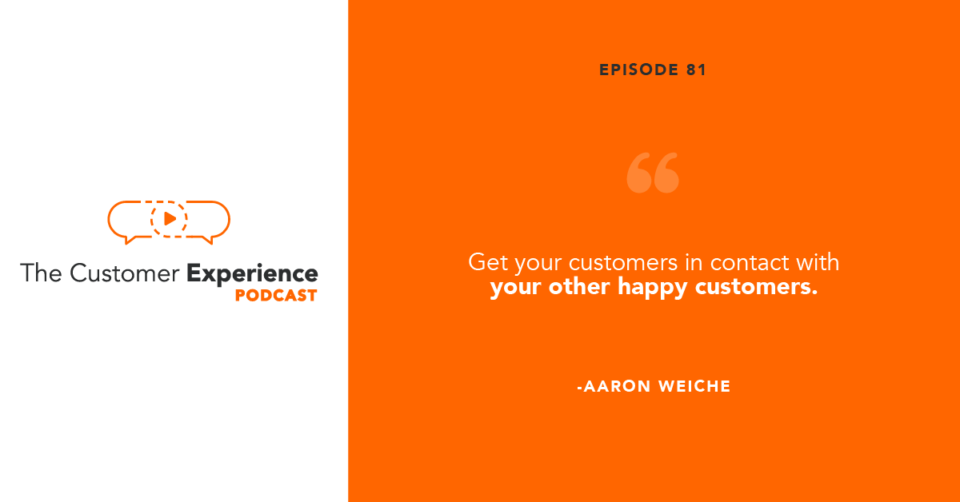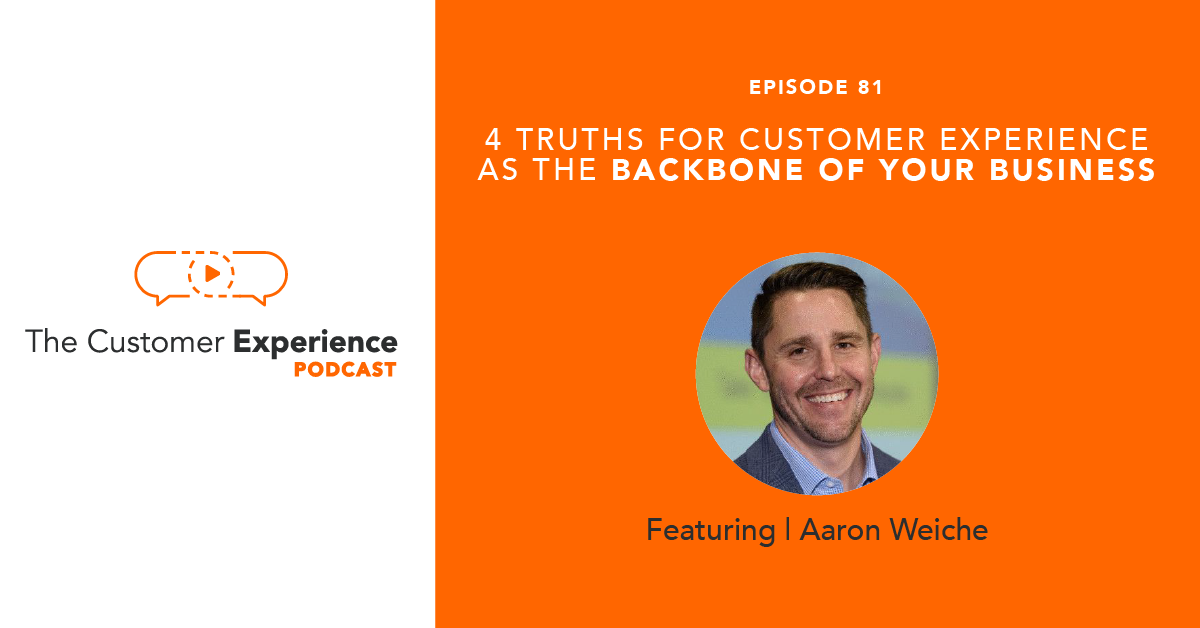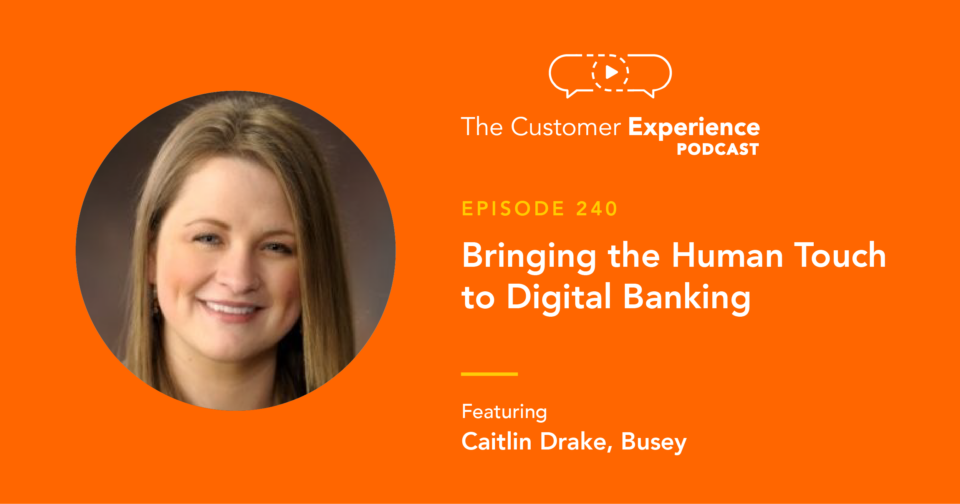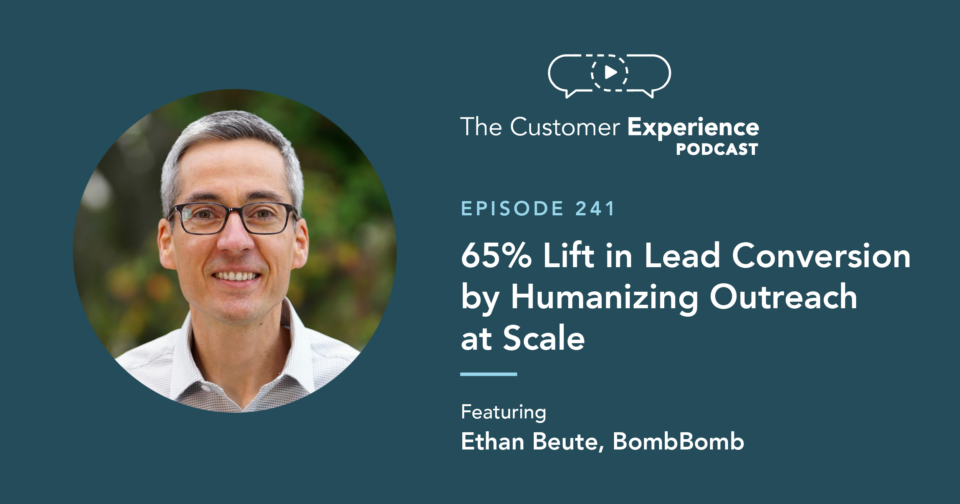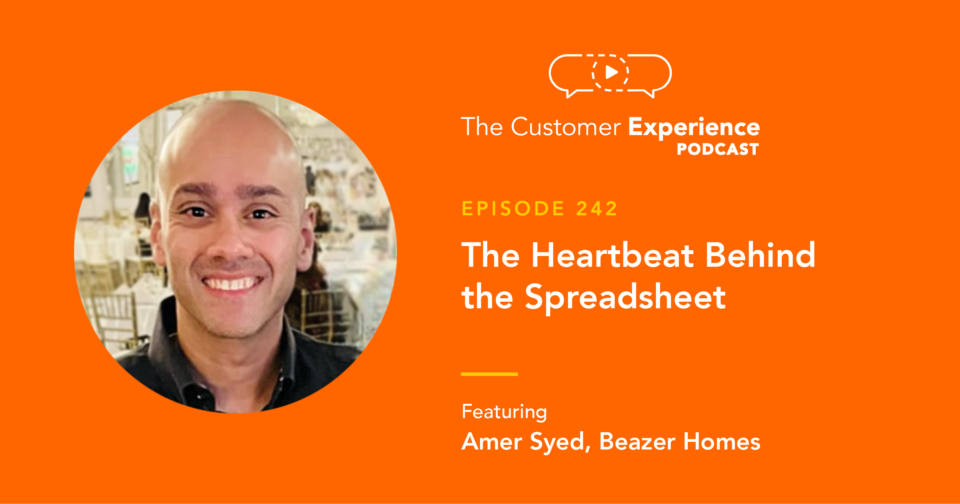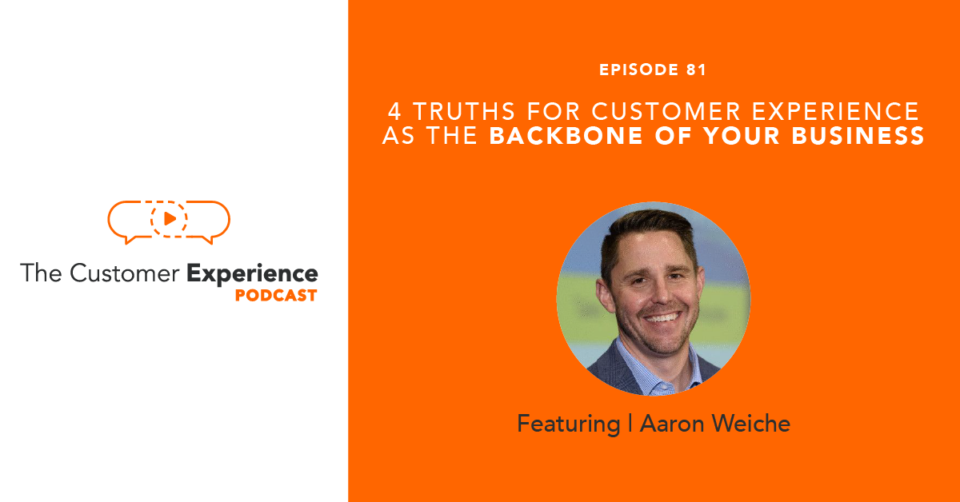
Apple Podcasts | Google Podcasts | Stitcher | Spotify
What are you doing to get feedback from your customers? Once you do hear from them, are you really actively listening to and making visible what they have to say? These actions are among 4 customer experience truths that are foundational to your organization’s success.
In fact, hearing from, listening to, and amplifying the voices of your customers have never been more important than it is now during this pandemic. People want to know that you have their back and are willing to take their thoughts and feelings into account in a time when everything is up in the air.
So, you need to have consistent cycles of feedback from your customers about what’s working for them and what could be improved. You need to focus on the four customer experience truths if you want to make CX the backbone of your business.
In this episode of The Customer Experience Podcast, our guest, Aaron Weiche, shares actionable insights based on the four customer experience truths which include:
To improve customer experience, your customers’ feedback should be…
1. Differentiated
2. Easy
3. Visible
4. Authentic
As an expert in online reviews and other digital expressions of customer feelings and stories, Aaron analyzes why and how to really listen to customer feedback going forward.
He is the CEO at GatherUp, a CX and online review engine. He also hosts The SaaS Venture Podcast. He’s spent the past dozen years in VP and C-level roles in marketing and technology firms and believes customer feedback should be the backbone of businesses.
Throughout our conversation, we talk about…
• What defines customer experience and online reputation
• Why we should use the stair-step approach to reputation management
• What the four customer experience truths consist of
• How to gather up proactive, passive, and real-time feedback
• How to operationalize reputation management
4 Customer Experience Truths
Hear the entire conversation with Aaron Weiche on customer feedback and the four customer experience truths right here:
Hear this episode of The Customer Experience Podcast – and many others – by subscribing to in:
While you’re there, please take a minute to add your rating or your review – it helps other people understand whether they’d also enjoy this show!
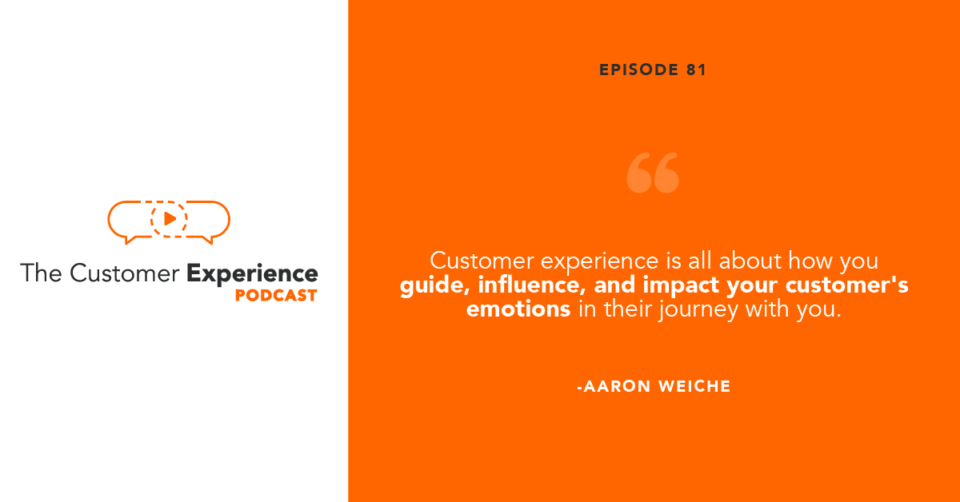
Full Transcript: 4 Customer Experience Truths
Ethan Beute:
I’m really excited about this conversation. And I love these four truths that we generated in a back and forth before hitting record and having this conversation. But before we get into it properly, it’s mid-May, you’re in Minneapolis, I’m in Colorado, I’m just wondering what’s the state of affairs with regard to the pandemic? How is it affecting you or your family or your team member or your customers? What’s going on from your perspective?
Aaron Weiche:
All right. Well, I’ll try to be succinct and not eat up our entire time on that. But one, personally, I have four kids. I’m enjoying more time with them, activities, sports, all of those things have come to a halt so I feel like it’s a lot more like my childhood, and getting to spend a lot more quality time instead of running around. As a business, GatherUp has always been a distributed company with all of our team remote, so not a hard adjustment for us by any means there. I usually work out of a small office where I live. But now I’m working from home, so hopefully during our interview today one of my four kids doesn’t pop in. They’ve been pretty good about that.
Aaron Weiche:
But mentally, I think the really big mind shift is, for the last 15 years of my career, it’s always been growth mode no matter what business I’ve been leading or starting or running. And this is really the first time where it’s been kind of a circle the wagons and figure out how do we sustain and survive while still trying to find those little opportunities.
Aaron Weiche:
And lastly, Minnesota as a state, I feel like we’re probably edging more in the lower third as being cautious. Our state is very healthcare minded when you have the Mayo Clinic here and things like that. So I kind of feel like as other states just right now are just starting to reopen, we’re doing that a little bit but I think we’ll be closely watching what goes on everywhere else before we make any big moves as far as reopening businesses and the economy.
Ethan Beute:
Cool. Thank you for sharing that. And that’s been a consistent silver lining. And I’m experiencing the same thing. I only have one child, a teenage son, but even if it’s just two or three minutes as I’m in between meetings or going out to fill up the tea or something like that, just more time with family I think is something that a lot of people are really enjoying. And I hope some of those habits that we’re reforming stick with us whenever we’re on the other side. So thank you again for that. So we’ll start here where we always start, which is your definition, thoughts, characteristics. When I say customer experience, what does that mean to you, Aaron?
Aaron Weiche:
Yeah, to me, customer experience is really all about how do you guide, influence, and impact your customers’ emotions in their journey with you.
Ethan Beute:
Awesome. How about online reputation? I know that one’s kind of taken for granted. But I mean it’s what you all do, so I thought you might be able to define that in a way that might be really helpful.
Aaron Weiche:
Yeah, the easiest way I describe it when I’m talking to people is when you think back a decade or two ago, the brand, you controlled your reputation and your voice by your billboards, your TV ads, what you put out there. But the evolution of the internet has provided that same strong voice to every last consumer that’s out there. So there is easier ways to share your opinion, post it, and have it last forever and be very visible on Google, Facebook, Twitter, various industry sites, and things like that. So online reputation is really how your business is reflected through the eyes of your customers as they tell your stories in microformats through star ratings, thumbs up, thumbs down, recommend yes, recommend no, and the details they talk about in what their customer experience and their journey was like when they interacted with your business.
Ethan Beute:
Yeah, it is very, very interesting. I think we’re pretty deep into this at this point. I think we’re now into nuanced behavior with regard to… What came to mind there when you say stars, immediately my mind goes to Amazon. And so I generally will just keep scrolling if I see something that has three reviews. Because I want some volume there. I want some truth, I want some belief. Even those kinds of minor behaviors are just adaptations to what you just observed there. And so I’m sure this will come up in the course of our conversation, but what we’re talking about here is the very, very earliest start of the customer experience and of the buying journey. And I think a lot of what you’re going to share is going to be helpful for folks who want to start their relationships off in better places. But before we get into the four truths, for folks who aren’t familiar, could you share a little bit about GatherUp? Who is your ideal customer and what do you solve for them?
Aaron Weiche:
Yeah. So our idea customer at GatherUp… Why don’t we start with exactly I guess what we do? What we aim to do is help create a win-win situation for the business and the customer. Primarily, for the business, it’s giving them a toolset to be able to engage their customers post-experience, post-transaction, and allow them to capture some really valuable and simple customer experience data points to understand how did we do with this customer. So we capture things like net promoter score, how likely are they to refer that business to a friend or a colleague? We allow them to ask a few small, specific survey questions around customer service. Did they get the value? Was the timing and communication great? Things like that. And then we help make it easy for that customer to then go and write a review for that business. So it’s a pretty seamless process.
Aaron Weiche:
We always call it the best two-minute post-sale conversation. And we want it to be in and out like a robbery. So nice and quick and easy, and it allows them to understand did we do a great job. Will this customer be out singing our praises, or will they tell people that we fell short and they should consider someone else when someone asks them for a referral that’s out there? So making that whole process of listening to your customer easy.
Aaron Weiche:
And then what’s special about us is we just understand how much that needs to translate into the online world. So not only the company hearing this and knowing this for their internal decisions, but then how do we take this outward so that people can read these reviews on Google and on Facebook and on their own websites as well? So we have a number of tools that help make it easy for those reviews to be written, and then publish them to their own website and social platforms.
Ethan Beute:
It sounds like you’re solving a very interesting and valuable problem of course. Because so much of that activity can be very disparate. I’m just thinking about some of the feedback that we collect from our customers. Sometimes marketing is going out to try to drive up reviews in a particular location. Do you find that the best thing for a company is to find one or two spots where the online reviews matter the most? Or can you syndicate reviews across multiple destinations? How do you think about that? What I’m thinking about here is our own customer base, which is very, very diverse. And so some people really want the reviews over here. Some people really want to build up a review rating over there. G2 is a place, for example, where our SaaS customers really want to be. Zillow or Google is where some of our maybe real estate or mortgage customers want their reviews to rack up. What do you advise around locations for reviews?
Aaron Weiche:
Yeah. So the first thing I tell people is to take a stair-step approach to this. At the very bottom of the stairs, the first thing you need to capture is actually have customer feedback and reviews as a core part of your business. Right? Not just a marketing tactic, not just a marketing agenda of, “We want 13 more Google reviews this month,” but is listening to our customer a core part of our business? Then that second step is do we have the right tools so that we’re understanding what they think? Because really, at the end of the day, if you don’t know what that customer thinks, it doesn’t matter where they post it. Someone is going to get access to it, whether it’s an in-person conversation, a message board or a review site.
Aaron Weiche:
And then that next step that you’re talking about and asking specifically is, yes, where are your prospects going to be? Right? So you need to take a look at what happens when someone types in best plumber in this city or whatever your service is in this area that they’re looking for. And then even consider more so nowadays, once people, even if they’ve been referred to you in an in-person situation, their next step is to go look up your business online. And what we see with a lot of behavior is people typing a brand name and then word reviews after it into their Google search. They’re going to skip any of your content and they want to go strictly to what’s the public opinion, what are other consumers saying about this business. And when those search results come up, pay close attention to what’s on that page. Right? Google reviews, it might be your Facebook profile, it could be your Yellow Pages listing, but whatever’s on that page one, that’s a really quick temp check on what your reputation is. And those are the sources that are going to be right in front of your prospects.
Ethan Beute:
Great tips. I’m glad I asked that. I’m calling them four truths, they’re statements that we developed in an early exchange, and I do accept them as truths. So I’ll just read the first one-off, and then let’s get your take on it and maybe talk about it. So the first is something that is definitely a truth that we have established here on the show by talking with all kinds of people in all kinds of seats, and that is that customer experience is where you compete. That is your differentiator, that your brand and your reputation are the moat against competition. So talk a little bit about that dynamic from your perspective.
Aaron Weiche:
Yeah, the easy way I always frame this up for people to understand it is no matter what you’re competing in nowadays, it’s an Amazon economy. Right? The options that you have to get products or services cheaper, faster, in various ways, has been commoditized so greatly. But your brand and reputation is really your true separator. What are your fans out there saying about you? And does that make a difference to the prospect coming in, that they might be willing to pay a little bit more because of how you deliver it or overlook some other things based on location, amount of time you’ve been in business, any of those other things because of what your reputation looks like with it? So I tell people then that in this big differentiating, deciding factor, you really need to shine here. Right? You need to be telling your customer experience story as loud and in as many places as you can. You need to ensure it’s a great customer experience story. So capturing it, managing it, and then finding the right ways to market with it.
Aaron Weiche:
We can go on and on through all kinds of industries that thought they were so bulletproof, from the cab industry to mattresses, things like that, that never thought their industry would see a disruption or people could just a few clicks on a website and be getting that product delivered to their house. But for location-based businesses now, that’s very real. One of their biggest competitors is anything that’s online with it. So that reputation, how you deliver your service, what people that you trust in your community think about that service, those are very important things in making a decision to purchase from a company.
Ethan Beute:
Absolutely. The language I’ve picked up around it is product parity and hyper-competition and the result of those things, as you already offered here, is commoditization. And so a lot of these businesses where even 10, even five years ago, you wouldn’t think about some of these businesses as being commoditized. And so, yeah, it’s the experience that we’re able to deliver and then the thoughts and feelings and stories that people are left with as a consequence, and of course your ability to capture and control the good ones. In looking at your website, I was reminded of a really important idea, which is if something’s going bad you want to be the first place a customer goes. And when something’s going good, of course, you want to document and amplify that. And so really, really important because, as you said, your moat is your reputation.
Ethan Beute:
Number two is, and I accept this one intuitively and I’m curious what you have to share on it, is that customer experience data capture must be easy. And I think this goes with some of the earmarks of an Amazon-type experience, which is frictionless, which is easy. I mean it’s just so easy to buy, buy now, done. Talk about of course why the data capture must be easy, but also maybe some ways to do it.
Aaron Weiche:
Yeah, so the most straightforward example I give is anytime you pop in, you’ve had an experience, you’ve done business with a brand, a survey shows up via email or via text, you open it and then there’s either a progress bot or a numbering system and you see it’s going to be 20, 30, 40 questions, right? The level of completing that goes way down. And even if you decide, “I’m going to go through with this,” at the end of it you might have a worse opinion of the brand because they just ate up time in your day. And time is our biggest commodity, right? So I think a lot of businesses really need to understand and decide that, “Yes, our marketing and our operations department want incredibly granular information, and we want it mass, but asking our customers that many questions is only going to fatigue them. We’re not going to get as many results.” We need to be hearing from as many customers as possible.
Aaron Weiche:
And really the best thing is these are customer touchpoints, right? And if you’re not delighting them with a customer touchpoint that makes them feel more like, “Wow, this was easy. I could easily be heard. I can do it from own device, and it took me 60 seconds to tell them about my last experience, which will ensure my next one is great.” Or, “I had a way to be heard that something wasn’t exactly right, and they can reach back out to me to fix it.” The consumer should get a win out of it. And I just think that’s something really important where, yeah, it’s great if your data collection gets a win, but if it’s at the expense of frustrating your customer, causing them friction and taking time from them, then it’s not really quite the win that you think it is.
Ethan Beute:
Yeah, I like that win-win approach. And I think probably what happens if you make it even just a little bit too cumbersome is that you’re going to get the extremes. You’re going to get your super fans, and that’s always nice. It makes you feel good. It reminds you why you show up and push through the hard stuff day to day. And you’re probably going to hear from the people who are really, really angry or confused or frustrated because their feelings on both ends are so strong that they’re willing maybe to jump over the hurdle that you put in their way. And what you’re going to be missing, I would guess, is possibly the most important voice of all. Because you’re going to probably hear the loudest ones good and bad regardless, but you’re going to be missing that person that’s kind of just under the radar.
Ethan Beute:
On an NPS scale, it’s that six or seven that could be potentially brought up to a nine or 10 but could just as easily disappear and fall off and/or they’re just not going to repeat purchase and you’re never going to know where they went, or they’re not going to renew their subscription and you’re just not really going to know where they went. I don’t know if it’s a silent majority. I’m sure it depends on the business and the nature of what you’re doing and how well you do it, but I would guess that what you’re going to lose if you make it too cumbersome is that person that just doesn’t care enough about you to bother.
Aaron Weiche:
Yeah. Well, tactically, these are some of the things that I tell people they need to do is, one, if that customer goes looking to talk to you, it should be very apparent right when they come into your website. Right? We’ve all, as consumers, had experiences where 10 clicks later we’re still not somewhere where we feel like we can give our opinion and talk to someone. So number one, I tell people, “Your website should have a link, a button, something that says customer feedback, talk to us, something along those lines.” All of our websites have 10 different ways to buy from us, right? Lead forms, pop-ups, all these other things, but we employ none of that to actually listen to the customers we’ve already won that we want to keep and ensure keep coming back.
Aaron Weiche:
Then, after that, it’s just looking at really easy ways. One feature we have is each business will have a text number. So you just text a keyword to that number, the system auto-responds and says, “Great. Let us ask you a few questions on what your experience was like with us today.” So the consumer, they’re just seeing a sign, it’s on the receipt, something easy, but they’re able to do it in real-time. They could be in your business and still frustrated, but now they have a way to talk to you. A lot of people don’t like conflict so being able to do it from their own device, behind their own keyboard is definitely easy.
Aaron Weiche:
And then the last is just being proactive, right? And we see more and more of this in the market now where after a purchase, within hours or days, you’re going to get an email or a text message that says, “Hey, we want to hear from you. Here’s a really easy way to do it and it’s only going to take you a minute to do it.” But those are the smart tactical ways. And you need all of them kind of working together. You need something in the moment. You need something passive when they go looking for it. Because let’s face it, if it’s easier for me to go complain on Google or Yelp or Facebook about your business than it is to talk to you, you’re already losing within that battle. So combining in-moment, passive, and then proactive, and you doing the reach out, is really a great tactical way to ensure you’re reaching the majority of your customers and letting them know, “We care to listen. Here’s an easy way to do it that’s going to be really quick for you, and we’re both going to benefit from it.”
Ethan Beute:
I love it. Really, really good tips. Just a quick drive-by here, what do you think about incentives? Should you incentivize feedback? And if so, do you have any rules around that?
Aaron Weiche:
Yeah. So number one, I would say no. I say no specifically for the reason that within our process we’re asking both for direct feedback and an online review at the same time. And it is against FDC guidelines to incentivize any type of an online review. Because then it’s really just a paid testimonial. So even something as simple, and I see these faux pas all the time, you go out and get a haircut and at the cash register it might say, “Hey, $5 off your next haircut if you write a great Google review or a Facebook review and show it to us.” All of those are non-nos, right? Because you don’t want to have something that’s been a pay for performance of what the review looks like. To me, that kind of signals… When you need to offer an incentive, it just kind of shows we’re probably asking too many questions, taking up too much of your time, and we probably didn’t even deliver an experience that you really want to talk about if we have to pay you to talk about it after the fact, right?
Ethan Beute:
Right. That’s really good.
Aaron Weiche:
Yeah. I say to couple those. I mean we are always pretty solid. It’s going to vary but if somebody said, “What’s the interaction rate?,” I usually say, “We help most businesses accomplish somewhere between a 20 to 30% reaction rate when you’re doing those three different methods,” that I talked about, proactive, passive, and in real-time. Now that, when they send out very massive surveys, a lot of those are scratching and clawing for single percentage points for getting feedback because too daunting to begin with, it’s not tied to the actual experience, it’s done annually or quarterly, and it’s too many questions that are there. So I say let the motivation be that “This is awesome, they want to hear from me.”
Aaron Weiche:
And a really great, just to sneak in, a really quick tip with this, when you’re doing any of those things and you’ve baked it into your business process, when that business is dealing with a customer you’re saying something like, “Just so you know, when this is all wrapped up, we’re going to send you a quick, five-question survey to find out what you thought about us and hopefully write a great online review, because what you think really matters to us.” So now you’ve already personally seeded that process and the email isn’t a surprise, the text message isn’t a surprise, and you’ve let them know, “Hey, this really matters and it’s really easy to do.” So that, to me, is like a pro tip. Give them a heads up you’re going to ask them. Don’t let it be a surprise.
Ethan Beute:
Really good one. And some interesting details there with regard to incentives in addition to the proper motivation and strategy. Number three, the big picture on CX is that it needs to be visible to your prospects. I think I know where this one’s going, and I’ve probably been on the wrong side of some of the sins here. But talk about visibility.
Aaron Weiche:
Yeah. So especially in today’s business environment, and I think a lot of people if you start to think through this evolution of being visible in how you conduct business and how you work and what’s going on and the tools that businesses use like social media to be able to amplify that and showcase those things, a lot of companies might do a great job of data collection on how their customers feel, and then it all dead-ends in a spreadsheet or a database somewhere or anything else. And they use it to make some internal decisions. But what consumers really want nowadays is they want an open book on that. And they want to be able to see everything.
Aaron Weiche:
So I think it’s really important to take what you’re learning and then be able to get it to a place where everyone can access it. Because the whole goal is that you’re doing an awesome job, people are having great experiences overwhelmingly, more so than the average or the poor ones. And the public wants to peel through that and be able to see it when they go to make their decisions. And because of the ways that people can do things, you’re able to get questions answered in reviews, you’re able to understand details and facts that the website might’ve missed because it’s that customer that actually went through the experience and the journey sharing the same details about their journey with it. And to me, that just builds so much more consumer confidence than the marketing pitch that we put on our websites and even our social media and things like that.
Aaron Weiche:
So I just think it’s really important to get your customers in contact with your other happy customers. And by posting it to your website, social channels, the review sites, everything else, that’s the best way to do it. We have all this information right on our phone in front of us. We need to make sure we have as much of it out there that paints us in the right light.
Ethan Beute:
I have one observation and then one question. The observation is we’re definitely using a lot of the feedback that we’re getting internally to make decisions. And it is helpful. We’re a volume business, we have over 50,000 customers and growing. And so it’s hard to keep a pulse of what’s going on. And so having multiple pieces of feedback coming in and helping us make decisions, and having what could easily look like a number in any kind of a report or roundup or dashboard, actually having real voices and real customer’s words internally is very helpful to humanize what would otherwise be this massive population that could be faceless if we weren’t sending videos back and forth with a lot of them too. But I think getting it to the website, this is how I got here.
Ethan Beute:
As a consumer, I trust a 4.78-star review much more than I trust a five-star review. Let’s say there are 200 ratings and one of them is a full five-star and the other one’s like 4.78. There’s something more honest about not being perfect. Talk about in places where you can control what gets shared and what doesn’t. So you and I have both been on websites, whether we’re evaluating things for ourselves and our families or whether we’re evaluating things for our businesses where you see five stars from Chelsea and she says this, five stars from Jeff and he says that. It’s obviously cherry-picked. And so do you have any advice for people in these situations, A, do you buy my premise that it seems a little bit more credible to not quite be perfect than to be perfect? And do you have any advice on cherry-picking this kind of stuff?
Aaron Weiche:
Yeah, so you just played into my fourth truth really, really well, right?
Ethan Beute:
Oh yeah, good.
Aaron Weiche:
Yeah, I think authenticity is the new king, right? And just as you’ve shown, as a consumer, if you read a review profile that has 120 reviews and their rating is five stars, there is a little bit of you that says, “Is this all marketing? Is this sculpted? Were they paying to get some of these reviews?” Consumers want facts and they want the truth that’s there. A study a couple of years ago, PowerReviews and Northwestern University did a co-study and they found the most trusted rating was 4.2 to 4.5, right? So customers don’t expect you to be perfect. They expect you to be great. And so with that, I always caution people. Really what we preach on the soapbox, the biggest thing you should do is be authentic. How your reviews come in and what those ratings are, that’s the very last piece of what’s gone on.
Aaron Weiche:
And if you really care about what your rating is or only showing the best of you, you need to fix it into your process, your customer experience touchpoints, all of those others things. That’s where you make a five-star experience happen. It isn’t in how you ask for the review or any of those things. I always said, “I’d be rich and on the beach if just because our beautiful emails and text messages and forms captured this in a way that even a one-star experience suddenly turned into five stars from our system.” That’s not what happens with it. So I think that part is really important. So we tell people, “Post all of your reviews and be authentic and respond to all of your reviews that are out there.” So we have a number of customers, and some are very large brands. They post every single review, even their one-star reviews. But then they make sure they reply to those one-star reviews to show those next customers, “If something goes wrong and we didn’t hold up our end of the deal, we’re listening. We’re going to own it. We’re going to respond and we’re going to offer a path to try to work this out with you.”
Aaron Weiche:
That way, when that next customer comes in… We can all say, “Hey, if everything goes great, I’m going to be happy.” But a lot of consumers are like, “What happens when things go wrong?” And this shows them they’re going to hear me. I have ways to talk to them. They’re going to correct it. And they have processes for me to go through to end up being a happy customer in the end. And to me, that is so much more important. And that sets up your brand and reputation to be one of trust over everything else, rather than their brand and reputation is they’re just amazingly awesome at marketing and sculpting a perfect review.
Ethan Beute:
Yeah. I like it. And I did not realize I was teeing that up so well for the fourth one. But it’s totally true. I buy that outright. And I really like that honesty. And I also like the consistency in response. In your experience, whether it’s GatherUp specifically or whether it’s this kind of functionality in general, obviously customer experience is the responsibility of the entire organization. But with regard to, say, who in your experience in an organization, what team or what type of person is the best one to be responding to those comments or to run a GatherUp install or these kinds of things? Is this is a marketing play? Is it a CS play? Is it an operations play? I’m sure it varies a little bit but speak to that a little bit. For folks who are listening and they’re like, “Oh yeah, we definitely need to step up our reputation game. We need to be a little bit more intentional or conscious here,” I’m already thinking a lot about some of the stuff that we do well and things that we should be doing, what seats in the house are typically involved at the front line, practical level here?
Aaron Weiche:
Yeah. Well, first of all, Ethan, it is a very great question and I think one that a lot of organizations are struggling with as customer experience has just matured and taken off and having such a big seat at the table, right? So more often than not for us, the conversation usually starts in marketing just because of the visible eye candy of review stars and review counts and all of those things. But really, to me, the best solution is where you have operations, CS and marketing all at the table together. Because what we overwhelmingly find a lot of times is they’re all using different tools to do different things. When a tool like GatherUp can come in and replace three or four tools that they’re using for monitoring, requesting, marketing, all of those different pieces with it.
Aaron Weiche:
So it doesn’t matter really who initiates it. I think all three of those having a seat at the table because they all can handle different functions within it, right? Marketing’s going to care about our Google review counts, how we look on Facebook, what can we show on our website, what can we share on social media to bolster, and get those things out there. Operations wants to see what do we need to do different in our processes, decisions we make? Are people happy with wait times? What makes them the most upset? What do we need to do for training so our team is better at answering certain questions or setting expectations with things that are there? And then your CS a lot of times, if you have that role, that’s the one that’s going to be responding and then saying, “Hey, we understand you’re upset. We have a process to try to remedy. Let’s get in contact and start to work through this problem.” So to me, my best customers are the companies are that have the super three there together and they’re working through this and they’re each doing those parts out of one centralized solution.
Aaron Weiche:
For smaller businesses, the majority of the time though it’s going to sit inside of marketing, and then they have to learn to have some customer success, customer support to what they’re doing, to be able to reply and do different things with it. But it really is amazing how this has evolved. And with some companies we get into now, there’s specific customer experience positions that five years ago that just really didn’t exist except for in some of the largest of corporations. But now we even see it in medium and even smaller type organizations where they have someone dedicated to customer experience.
Ethan Beute:
Yeah, it’s interesting. And so the conversations we’ve been having on this show around the operationalization of CX is there’s a camp that matures out of the CS function, and then there’s other camp that I think you’re alluding to that I feel like I’m more in myself, which is it’s the intersection of multiple disciplines. Because all of these areas, sales, marketing, CS, product and dev in software companies of course, all see and experience the customer differently and so it all needs to be brought into one place. I wouldn’t house it in any one team, that it needs to be this cross-functional thing. Anyway, we could nerd out on that for a while. I do want to take a short pivot and just talk a little bit about The SaaS Venture podcast. What are you trying to do there? When did you start it? How’s it going? And maybe what are a couple of things that have surprised or delighted you on the journey?
Aaron Weiche:
Yeah. Started doing it about a year and a half ago. I co-host it with a friend of mine, Darren Shaw. He also is a founder and CEO of a SaaS business. And we were at a conference together. We both talk at a lot of digital marketing conferences, local search Google-type conferences. And we were both kind of tired of talking tactical things. So we were like, “Let’s just start having conversations about what it’s like to run our companies and run SaaS businesses and all of the decisions and things like that.” So that’s where it was born from. We started that about a year and a half ago. We are just, this week, recording our episode 20. So we get about at least once a month, if not more. But we really pull back the curtains on how we make decisions, how we build our teams, how we communicate with customers, how we market, how we come up with ideas for new features, and the processes it goes through to come to market.
Aaron Weiche:
And then what has been really fun is last year GatherUp was acquired in November and we just got done doing a three-part series where walked through the entire acquisition. So both what led up to the acquisition and what talks looked like was one episode. Then one episode completely on the deal, the structure of the deal, what’s part of it, all of those things, the stress, the turmoil, all of that. And then the last episode was on the transition, right? We were purchased by a firm that owns six other companies. So now we’re part of a much larger group. And what was it like for employee transitions? And what things made the transition easy? What parts were challenges? And all of those different kinds of things with it. So just really fun to be able to talk about the day-to-day business and not so much marketing on Google, different things, tactical things that our product does.
Aaron Weiche:
Yeah, just a little bit of just getting to lay on the davenport with another business owner and talk about your wins and your losses and your challenges. And that, to me, has probably been the biggest win out of it is just being able to talk out loud about the different things in running and scaling a business, especially back to start with our bootstrapped ones. Neither one of our companies ever took any funding. We’ve been acquired now which has changed it a little bit. But yeah, it’s just one of those talking out loud to yourself with someone else and sharing that conversation with others.
Ethan Beute:
That’s awesome. It sounds reflective and cathartic for you, and probably highly informative for listeners. We were also bootstrapped which, I mean there’s a whole conversation right there about the opportunities and challenges that gives you.
Aaron Weiche:
And I say good or you, good for you. I love it.
Ethan Beute:
Yeah, so we won’t have that conversation here either. But for folks that are interested in checking out The SaaS Venture podcast, I’ll link that up and add some other links as we always do, with a short writeup and video clips, fully embedded audio. Every episode is available to you at bombbomb.com/podcast. It’s B-O-M-B-B-O-M-B.com/podcast. And while you’re there, if you like this conversation with Aaron, you’ll really like episode seven with Rachel Ostrander, who is the director of runner experience at Brooks Running, which is a company that makes shoes that I run in myself. And that episode’s called Superior Customer Experience Starts Before There’s a Customer. That’s episode seven. And episode 66 with Ben Smithwell who is a CX designer and strategist with a company called Comotion. And that episode we titled Restoring the Human Factor to Fulfill the Big CX Dream. So we get into kind of the modern CX movement and what’s real about it and what isn’t. And that was kind of background theme in what we were talking about here, Aaron.
Ethan Beute:
I’ve enjoyed this so much, but before I let you go, I’m going to give you the opportunity to say thank you or to give a mention to someone who’s had a positive impact on your life or career and to give a nod or a shout out to a company that you respect for they experience they deliver for you as a customer, maybe one that you would write a five-star review for.
Aaron Weiche:
Nice. Yeah, a person that’s affected me, I would have to say his name is Ben Moonen. He ran a small, bootstrapped tech company and kind of brought me into the mix of what they were doing in the late ’90s around content management systems and things like that. And Ben didn’t have massive ambitions in the world and really taught me a lot about relaxing a little bit, taking things as they come to you, just being easy-going. But he just afforded me so many opportunities to do different functions in the company and roles and elevated me to a partner and things like that. So really appreciative early in my career where he just gave me so much freedom to learn and do and be a good sounding board when I was in things.
Aaron Weiche:
And then on the brand side, I will say… This is interesting. Any of my friends or followers will know this. I’m a massive Air Jordan buff. So I would say I love so many things that Nike’s done over the years in being inspirational in their messaging. And I really love that they get, for myself as a guy in his mid-40s, the fact that I’ll still plunk $200 down every time they re-release a pair of 1990 Jordans just because it allows me to relive my childhood when I couldn’t afford sneakers and everything else. And so they give me this emotional happiness when I get them that I’m back to being 15, 16 years old again. But I love the way that they combine and really realize some of the emotional tie ins to what their products are, their messaging around it, and so many of the different things that they do with it. It’s just one where, yeah, I probably have more Nike gear, things like that. And it’s created an affinity where it’s like, yeah, I don’t really buy other shoe company’s stuff because of how Nike’s been a part of my own life and journey and things like that. And to me, that’s really interesting when a brand gets that deep inside your world.
Ethan Beute:
Yeah, that’s awesome. And that emotional connection’s just so, so powerful. It transcends everything else, as you already observed at the beginning of that. It kind of takes price off the table. It could be 150, it could be 250, happens to be 200, and it’s not too much or too little because I’m just connected to it, it’s something I feel compelled to do for that relationship. That was awesome. I haven’t heard that one before. And if folks would like to have known the fact that you were an Air Jordan fan prior to this, where would people connect with you? If they enjoy this conversation, they want to connect with you online or they want to learn more about GatherUp, where are some places you would send folks?
Aaron Weiche:
Yeah. First, I mean I’m a complete Twitter addict and definitely share my shoe purchases and/or when I randomly wear them. So that’s just @AaronWeiche on Twitter. Very active and share a lot there and love the conversations, love meeting new people there. And then I write quite a bit on the GatherUp blog. So from there, you can really understand my views on customer experience and how our product intersects with that and how we want to help businesses unlock customer experience as the backbone of their business. So those are definitely the two top places where you can hear from me outside of The SaaS Venture Podcast and our monthly episodes there.
Ethan Beute:
Awesome. For listeners, as mentioned, I’ll link all this stuff up including the Twitter handle @BombBomb.com/podcast where we write these up and drop in video clips. And in the spirit of the episode, if you are listening to this and you enjoy it if you’ve heard other episodes, or even if this is your first one, take a minute out of your day and leave a review for The Customer Experience podcast. It’s very, very helpful to the show. It only takes a minute to do. And of course, while you’re there you can subscribe as well if you’re not subscribed already. Aaron, thank you so much for your time and your insights. Continued success to you. And hope you find some reasons and opportunities to put on some of those Jordans this week.
Aaron Weiche:
Hey thanks, Ethan. I appreciate it. Can I share one more I think important tip for the time right now that I love?
Ethan Beute:
Yeah, please.
Aaron Weiche:
I realized I didn’t get to it in my mind. I think really important in businesses right now among COVID-19 and whether you’re reopening or you’ve definitely adjusted in how you do business, please understand that listening and hearing from your customers has actually never been more important because you’re offering new delivery or service methods. They need to feel safe if you’re reopening. So you really need to have ways to listen and understand. Do they feel safe in your business and interacting with you? Are the methods that you’ve quickly put together… Right? You’ve done something that maybe you thought in 10 years, you’ve now done in a month, and bringing your business online, new forms, e-commerce, whatever that might be.
Aaron Weiche:
You need really tight cycles of feedback from your customers that, “Yes, this works for me. This is even better. Or here’s something you could do to make it even better because I do want to do business with you. I just need to feel safe and secure and good about doing it.” So I would say in this time right now, this is more reason than ever to be asking, “How are all these changes that we’re doing affecting you? And are they helpful? And do you have any other ideas for us?”
Ethan Beute:
That’s awesome. Thank you for that add. It’s kind of a tie back to where we started around the silver linings of this situation. I think this interest in and responsiveness to how customers are thinking and feeling and what they’re experience is, I hope that this is one of these other things where even though we feel the need acutely right now, that even as hopefully it lets go a little bit, this whole situation that we’re in kind of loosens up and we get back to some kind of normal, that this is one of those things that we continue to hold very, very close and very, very fundamentally in our business cross-functionally. So really great add, Aaron. I appreciate it so much.
Aaron Weiche:
Thanks for the opportunity to throw it in there, Ethan.
Video Highlights: 4 Customer Experience Truths
Check out the top five video highlights from the discussion with Aaron below…
1. Definition of CX and Online Reputation
2. Customer Experience Truth 1: Differentiation
3. Customer Experience Truth 2: Ease
4. Customer Experience Truth 3: Visibility
5. Customer Experience Truth 4: Authenticity
Similar Podcast Episodes You’ll Enjoy:
- “The Context Marketing Revolution” with Mathew Sweezey (Director of Market Strategy, Salesforce)
- “Restoring the Human Factor to Fulfill the ‘Big CX Dream’” with Ben Smithwell (CX Design Principal, Comotion)
- “Superior Customer Experience Starts Before There’s a Customer” with Rachel Ostrander (Director of Runner Experience, Brooks Running
The Customer Experience Podcast (To Subscribe, Listen, Rate, and Review):
